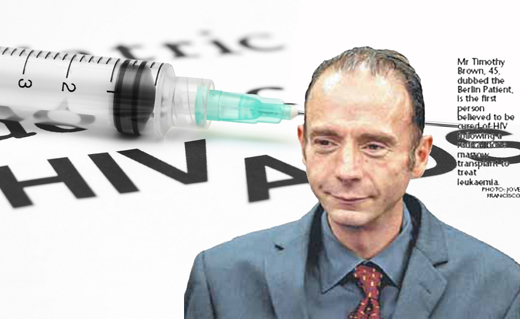 |
He was diagnosed with the disease in 1995. Then, after using antiretroviral drugs to stave off HIV for more than a decade, he received another staggering diagnosis: acute myeloid leukemia.
Brown’s doctors decided to use radiation and chemotherapy to wipe out his immune system, then rebuild it with donated stem cells. But they added a game-changing twist to this standard treatment: They deliberately picked a donor who was immune to HIV.

About 1 percent of Caucasians carry a gene mutation that triggers this immunity. In scientific terms, this means their cells don’t have CCR5, a protein that opens the door for HIV to enter blood cells. For Brown, it meant a new chance at life.
Brown received two stem cell transplants that knocked out his cancer and transferred the genetic variation to his immune system.
“It’s an incredible feeling – like a miracle,” he said. “I had two lethal diseases and was able to get rid of both of them.”
Now Brown, who was born in Seattle, heads the Timothy Ray Brown Foundation. On June 19, 2013 he is coming home to appear at an event highlighting Fred Hutch’s groundbreaking progress toward HIV cures for patients worldwide.

A Fred Hutch-led team is using this breakthrough as a possible blueprint for new curative therapies that could reach patients worldwide.
The treatment approach used on Brown can’t be applied on a large scale to people infected with HIV because bone marrow transplants can be risky and are still mainly used as a last resort in cancer patients. Also, very few people are naturally immune to HIV, making donor cells hard to come by. The research team must instead find ways to modify a patient’s own immune cells. The goal is to take blood cells from a patient with HIV, modify them to resist the virus by diabling the gene that encodes a doorway receptor for HIV, and then put the cells back into the patient. DefeatHIV also aims to develop innovative enzymes that can seek out and eliminate HIV from reservoirs where it hides inside the body.

DefeatHIV's team includes scientists from Fred Hutch, the University of Washington, Seattle Children’s Research Institute, City of Hope, Sangamo BioSciences and the National Institute of Allergy and Infectious Disease.
The treatment approach used on Brown can’t be applied on a large scale to people infected with HIV because bone marrow transplants can be risky and are still mainly used as a last resort in cancer patients. Also, very few people are naturally immune to HIV, making donor cells hard to come by. The research team must instead find ways to modify a patient’s own immune cells. The goal is to take blood cells from a patient with HIV, modify them to resist the virus by diabling the gene that encodes a doorway receptor for HIV, and then put the cells back into the patient. DefeatHIV also aims to develop innovative enzymes that can seek out and eliminate HIV from reservoirs where it hides inside the body.

DefeatHIV's team includes scientists from Fred Hutch, the University of Washington, Seattle Children’s Research Institute, City of Hope, Sangamo BioSciences and the National Institute of Allergy and Infectious Disease.

No comments:
Post a Comment